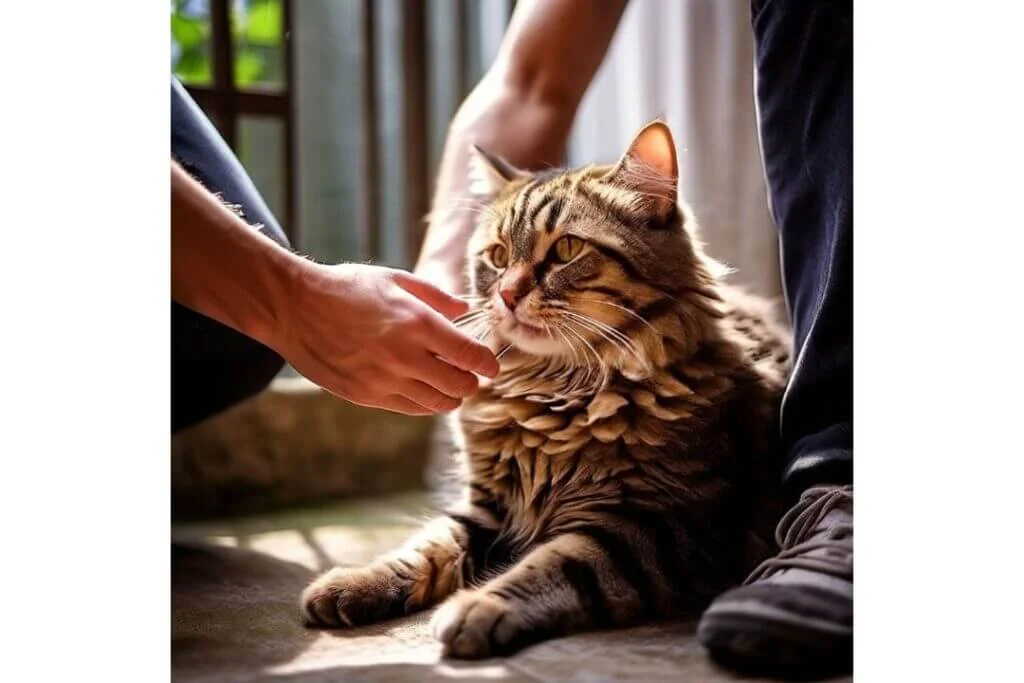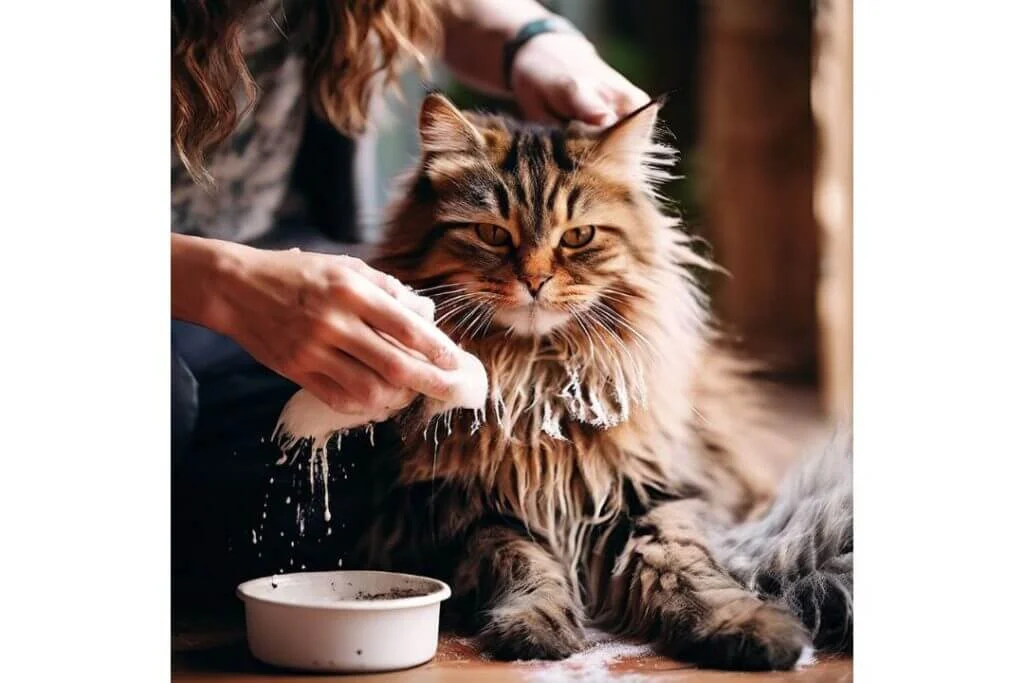Bathing a stray cat can seem like a daunting task, but with the right approach and some patience, it can be a manageable and even rewarding experience. Let’s dive into the process of how to bathe a stray cat, step by step.
Understanding the Stray Cat
Before you start the bathing process, it’s crucial to understand the temperament and health condition of the stray cat. Stray cats can be wary and defensive, especially if they haven’t had much human interaction. Assessing their behavior will help you determine the best approach to take.
Assessing the Cat’s Temperament
Spend some time observing the cat. Is it skittish or aggressive? A calm cat will be easier to bathe, while a more anxious or aggressive cat may require additional precautions.
Health Considerations
Check for any visible health issues such as wounds, fleas, or signs of illness. If the cat appears to be in poor health, it’s best to consult a veterinarian before attempting to bathe it.
Preparing for the Bath

Preparation is key to making the bathing process as smooth as possible. Gather all necessary supplies and set up a safe, controlled environment.
Gathering Supplies
You’ll need the following:
- Cat-specific shampoo
- A large towel
- A non-slip mat
- A gentle spray nozzle or cup for rinsing
- Treats to reward the cat
Setting Up the Bathing Area
Choose a small, enclosed area like a bathroom. Place the non-slip mat in the sink or tub to prevent the cat from slipping. Ensure the water temperature is lukewarm—too hot or too cold water can distress the cat.
Getting the Cat Ready
Before you begin bathing, it’s essential to gain the cat’s trust and handle it safely.
Gaining the Cat’s Trust
Spend some time petting and speaking softly to the cat. Offer treats to create a positive association with you and the bathing area.
Handling the Cat Safely
When lifting the cat, support its body securely. Avoid sudden movements that might scare the cat. If the cat is particularly nervous, consider wrapping it in a towel to keep it calm.
The Bathing Process

Now that you’re prepared, it’s time to bathe the cat. Follow these steps to ensure a smooth process.
Step-by-Step Guide to Bathing
- Wet the Cat Gradually: Start by gently wetting the cat’s body, avoiding the head. Use the spray nozzle or a cup to pour water slowly over its fur.
- Apply Shampoo: Apply a small amount of cat-specific shampoo and work it into a lather, being careful not to get any in the cat’s eyes, ears, or mouth.
- Rinse Thoroughly: Rinse off all the shampoo with lukewarm water. Ensure no residue is left, as it can irritate the cat’s skin.
- Clean the Head Last: Use a damp cloth to gently clean the cat’s face and head.
Tips for Keeping the Cat Calm
Speak in a soothing tone and move slowly. Keep the bathing session as short as possible to minimize stress. Reward the cat with treats and praise throughout the process.
Drying the Cat
Proper drying is just as important as the bathing itself. Here’s how to do it right.
Proper Drying Techniques
Wrap the cat in a large towel and gently pat it dry. Avoid rubbing, as this can cause tangles in the fur. If the cat tolerates it, you can use a hairdryer on the lowest heat setting, but keep it at a safe distance.
Post-Bath Care
Ensure the cat stays in a warm, draft-free area until completely dry. Check for any signs of discomfort or skin irritation.
Aftercare and Monitoring
After the bath, monitor the cat for any adverse reactions and ensure it’s comfortable.
Checking for Skin Issues
Look for redness, dryness, or other signs of skin irritation. If you notice anything unusual, consult a veterinarian.
Ensuring the Cat Stays Warm
Keep the cat indoors and in a cozy environment until it’s fully dry and calm.
Dealing with Common Issues
Bathing a stray cat comes with its challenges. Here’s how to handle some common issues.
Handling a Scared Cat
If the cat becomes scared, pause and give it time to calm down. Speak soothingly and offer treats. If necessary, try bathing the cat in shorter, more frequent sessions rather than a long, stressful one.
What to Do If the Cat Escapes
If the cat escapes, don’t chase it. Instead, give it some space and try again later. Ensure all windows and doors are closed to prevent it from running outside.
Special Considerations
Different cats require different approaches. Here are some special considerations.
Bathing Kittens vs. Adult Cats
Kittens are usually easier to bathe due to their smaller size and more pliable temperament. However, they are also more fragile, so handle them with extra care.
Long-Haired vs. Short-Haired Cats

Long-haired cats require more thorough rinsing and drying to prevent matting. Short-haired cats are generally easier to manage but still need gentle handling.
Why Are Black Cats So Sweet A Detailed Guide 2024
Why Do Cats Lick Themselves After a Bath?
Ragdoll Cat Life Expectancy: A Comprehensive Guide
Alternative Cleaning Method
If bathing is not an option, there are alternative ways to keep the cat clean.
Using Dry Shampoo
Dry shampoo is a great option for cats that hate water. Sprinkle it on the cat’s fur, massage it in, and brush it out.
Wipes and Sprays
Cat-specific wipes and sprays can help clean the fur without the need for a full bath. These are especially useful for spot cleaning.
Preventing Future Baths for Your Cat
Bathing a cat can be a challenging task, especially with a stray cat. However, you can reduce the frequency of baths with regular grooming and other preventive measures. Here’s a detailed guide on how to keep your cat clean and healthy without the need for frequent baths.
Regular Grooming Tips
Brush Regularly: Brushing your cat regularly helps to remove loose fur, reduce shedding, and prevent matting. It also distributes natural oils, keeping the coat shiny and healthy.
Check for Fleas and Ticks: Regularly inspect your cat for fleas and ticks. Use preventive treatments as recommended by your veterinarian to keep these pests at bay and reduce the likelihood of needing a bath.
Trim Nails: Keep your cat’s nails trimmed to prevent scratching and injuries to both you and the cat during grooming sessions.
Clean Ears and Eyes: Gently clean your cat’s ears and eyes with a damp cloth to remove any dirt or discharge.
Keeping the Cat Indoors

Minimize Exposure to Dirt and Parasites: Keeping your cat indoors can significantly reduce their exposure to dirt, parasites, and other contaminants that might necessitate a bath.
Create a Safe and Stimulating Environment: Ensure your indoor environment is safe and stimulating for your cat. Provide toys, scratching posts, and cozy resting spots to keep them entertained and comfortable.
Conclusion
Bathing a stray cat is a task that demands patience, thorough preparation, and gentle handling. Stray cats, often unfamiliar with human interaction and the concept of a bath, can be particularly challenging to manage. However, with the right approach, you can turn this daunting task into a manageable and even rewarding experience.
Understanding the cat’s temperament is the first and most crucial step. Stray cats can be wary and defensive, especially if they haven’t had much human interaction. Spending time observing the cat’s behavior will help you gauge its comfort level and determine the best approach to take. A calm and gentle manner is essential to build trust and reduce stress.
Preparation is key. Gather all the necessary supplies beforehand: a cat-specific shampoo, a large towel, a non-slip mat, a gentle spray nozzle or cup, and some treats. Setting up a safe, controlled environment, like a small, enclosed bathroom, can make the bathing process smoother. Ensure the water temperature is lukewarm, as extreme temperatures can distress the cat.
Gaining the cat’s trust is vital before you begin the bath. Spend time petting and speaking softly to the cat, offering treats to create a positive association with you and the bathing area. Handling the cat safely, supporting its body securely, and avoiding sudden movements will help keep the cat calm.
When it’s time to bathe, follow a step-by-step approach. Start by gently wetting the cat’s body, avoiding the head. Apply a small amount of cat-specific shampoo, working it into a lather carefully. Rinse thoroughly with lukewarm water to ensure no residue is left, as it can irritate the cat’s skin. Clean the head last with a damp cloth to avoid getting water in the cat’s eyes, ears, or mouth.
Proper drying is just as important as the bathing itself. Wrap the cat in a large towel and gently pat it dry. Avoid rubbing, which can cause tangles in the fur. If the cat tolerates it, use a hairdryer on the lowest heat setting, but keep it at a safe distance to prevent overheating.
After the bath, monitor the cat for any adverse reactions and ensure it stays in a warm, draft-free area until completely dry. Check for any signs of discomfort or skin irritation, and consult a veterinarian if you notice anything unusual.
Bathing a stray cat can be challenging, but with patience and the right techniques, you can keep the cat clean and healthy without causing undue stress. Remember, the goal is to make the process as stress-free as possible for both you and the cat.
FAQs: How to Bathe a Stray Cat
How often should I bathe a stray cat? Bathing should only be done when necessary, typically every few months or when the cat is particularly dirty.
Can I use human shampoo on a stray cat? No, human shampoo can irritate a cat’s skin. Always use a shampoo specifically formulated for cats.
What if the cat has fleas? If the cat has fleas, use a flea shampoo and consult a veterinarian for appropriate flea treatment options.
How do I calm a cat that hates water? Use a calm, soothing voice, offer treats, and keep the bathing session short. Consider alternative cleaning methods if the cat is too stressed.
Is it safe to bathe a sick stray cat? It’s best to consult a veterinarian before bathing a sick cat. They can advise on the best approach based on the cat’s health condition.
By following these guidelines, you can help ensure your cat remains clean and healthy while minimizing the need for frequent baths.

